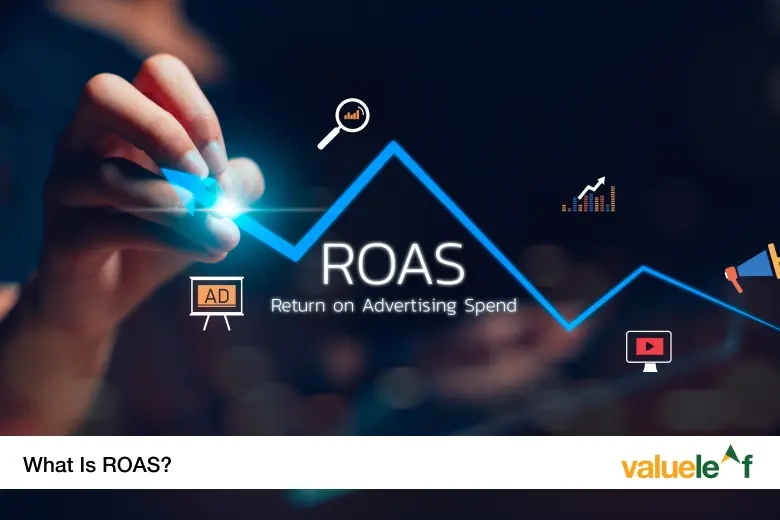In today’s digital-first economy, every rupee spent on advertising must work hard. Whether you’re running Facebook campaigns for your D2C brand or experimenting with Google Ads for your startup, knowing how well your ads are performing is key. That’s where ROAS — Return on Ad Spend — comes in.
ROAS helps answer a simple but critical question: “For every ₹1 I spend on ads, how much revenue do I earn back?”
Let’s break down what ROAS means, how to calculate it, and how you can use it to make smarter ad spending decisions.
What Is ROAS?
ROAS (Return on Ad Spend) is a marketing metric that measures the revenue generated for every rupee spent on advertising. It’s a key performance indicator (KPI) used by marketers to evaluate the effectiveness of online ad campaigns.
For example, if you spend ₹10,000 on a Facebook campaign and generate ₹50,000 in revenue, your ROAS is 5 — meaning you earn ₹5 for every ₹1 spent.
While ROAS is similar to ROI (Return on Investment), ROI considers total profit after all costs, whereas ROAS looks only at gross revenue versus ad spend. It’s narrower in scope but more actionable for campaign-level analysis.
ROAS (Return on Ad Spend)
To calculate the ROAS, the formula is straightforward:
ROAS = Revenue from Ads / Cost of Ads
Let’s look at an example:
ROAS = ₹80,000 / ₹20,000 = 4 This means for every ₹1 spent, you earned ₹4 back. A ROAS of 4.0 (or 400%) is typically considered good, but it depends on your business margins and industry. |
What Is a Good ROAS?
There’s no universal benchmark for ROAS, but here’s a rough guide to understanding a good ROAS:
| Industry | Target ROAS |
| E-commerce | 4x – 10x |
| SaaS / Subscription | 3x – 5x |
| Lead Generation | 2x – 4x |
| Low-Margin Retail | 5x – 8x |
Let’s say your product costs ₹1,000 to make, and you sell it for ₹1,500. If your ROAS is 1.5 (earning ₹1.5 for every ₹1 spent), you’re likely just breaking even or running at a loss. You’d probably need a ROAS closer to 3.0 or higher to be profitable.
Why ROAS Matters?
ROAS helps marketers:
- Measure campaign effectiveness in real time
- Optimize ad budgets by reallocating spending to high-performing ads
- Justify ad spend to stakeholders with clear revenue attribution
Without ROAS, you’re flying blind. High impressions or click-through rates don’t necessarily translate into revenue. ROAS keeps the focus on actual returns.
Factors That Influence ROAS
Several variables impact your ROAS:
- Ad Quality: Poor visuals or irrelevant copy can lower conversions.
- Audience Targeting: The wrong audience equals wasted spend.
- Platform Choice: ROAS may vary between Facebook, Google, Instagram, etc.
- Landing Page Experience: A slow or confusing website can kill conversions.
- Cost of Goods Sold (COGS): If margins are low, a high ROAS may still not be profitable.
How to Improve ROAS?
Here are some practical ways to get more value out of your ad budget:
- Refine Audience Targeting: Use platform data to reach users who are more likely to convert.
- A/B Test Your Ads: Experiment with creatives, headlines, and calls to action to find what performs best.
- Improve Landing Pages: Ensure fast load times, mobile optimization, and a clear user journey.
- Use Retargeting: Re-engage users who didn’t convert the first time to improve overall campaign efficiency.
- Track Events Properly: Use tools like Meta Pixel or Google Ads Conversion Tracking to attribute revenue accurately.
Tip: Indian brands often see better ROAS when ad copy is localized in regional languages or references local events and trends.
Common Mistakes to Avoid
- Focusing only on ROAS: It doesn’t consider long-term value. A customer acquired at break-even may still be valuable over time.
- Ignoring Overhead Costs: ROAS doesn’t factor in warehousing, logistics, or staffing.
- Misinterpreting Low ROAS: Sometimes low ROAS in a brand-awareness campaign may still be a strategic investment.
Tip: Always interpret ROAS in the context of your overall business goals.
Conclusion
ROAS isn’t just a marketing buzzword — it’s a fundamental metric that tells you whether your ad spend is working. By calculating and optimizing ROAS, Indian businesses can make smarter decisions, stretch budgets further, and scale campaigns confidently.
So the next time you launch an ad, ask yourself: “What’s my ROAS?” The answer could help you make (or save) lakhs in the long run.
Frequently Asked Questions
Q. What is a good Return on Ad Spend (ROAS) percentage?
A. A good ROAS varies by industry, but generally, a 400% ROAS (or 4:1 ratio) is considered strong. That means earning ₹4 in revenue for every ₹1 spent on ads. However, high-margin businesses may succeed with lower ROAS, while low-margin businesses need higher returns.
Q. What is the ROI of ads?
A. Return on Investment (ROI) for ads measures the net profit earned from ad campaigns after accounting for all costs (including overhead, salaries, etc.), not just ad spend.
Formula: ROI = (Net Profit from Ads / Total Cost) × 100
Q. What is the difference between ROAS and ROI?
A. ROAS measures revenue per ₹1 spent on ads (focuses only on ad spend).
ROI measures profit after all expenses (broader business view).
ROAS is used for campaign efficiency; ROI is used for overall profitability.
Q. How do you calculate Return on Ad Spend (ROAS)?
A. Formula: ROAS = Revenue from Ads / Cost of Ads
Example: If you spent ₹10,000 on ads and earned ₹40,000 in revenue, your ROAS is 4.
Q. How can you improve Return on Ad Spend (ROAS)?
A. You can improve ROAS by:
- Refining ad targeting
- Optimizing landing pages
- Running A/B tests on creatives
- Using retargeting campaigns
- Improving conversion tracking
Q. What factors influence Return on Ad Spend (ROAS)?
A. Key factors include:
- Ad quality and relevance
- Audience targeting accuracy
- Platform selection (Google, Meta, etc.)
- Website performance and UX
- Product pricing and profit margins
Q. What strategies can be used to maximize Return on Ad Spend (ROAS)?
- Focus on high-intent audiences
- Leverage lookalike or custom audiences
- Optimize for conversions, not just clicks
- Use performance-based bidding strategies
- Continuously test and refine creatives and copy




